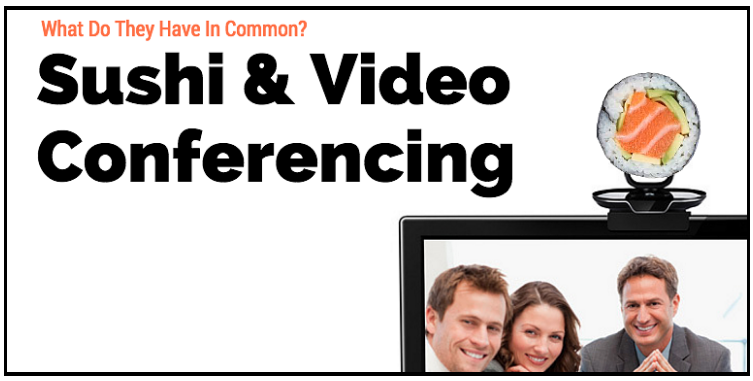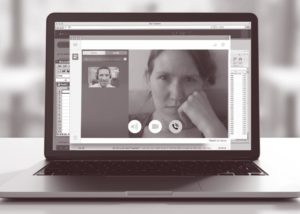L.V Anderson was pretty darn frank in her recent post about video conferencing and collaboration. In fact, she titled it, Video Conferencing is the Worst: It Makes Us Self-Conscious, Distracted, and Suspicious. Why do we do it? We agree that with video there may come insecurities, but overall I found her level of disdain for video pretty deep seated.
The article reminded me the time I tried to convince my dad to try sushi for the first time. He said, “why should I enjoy raw fish when I already know I like it cooked.” It’s delicious, that’s why! However, even if you’re apprehensive, there are 100+ different ways you can alter the flavor. It’s quite likely you’ll enjoy (or at least be able to acknowledge someone could enjoy) a few of them. For me, both Anderson and my dad showcase their inability to see or want to experience anything outside of their comfort zone. Well, I have something to say about that.
About “Being Self-Conscious”
Anderson works for Slate Magazine, an online publication covering everything under the sun regarding news, politics, technology and culture. She obviously had an infinite amount of topics to choose from but took the time to share her disdain for video as a method of communication. “Video conferencing preys on our vanity and distracts us with horrifying images of our own blemished, asymmetrical faces.” Woah, that doesn’t sound like she’s coming into the video experience with the hope of anything positive as a result. Also, you’re human, which means you’re not perfect. There are very simple ways to turn off the part of the call where you look at your own face and I highly encourage everyone to do that less than 10 seconds into every meeting.
Besides, it’s likely no one is thinking about what you look like. They want to know if you still have your pajama pants on below the camera.
One assertion I where I do agree with Anderson is that “true eye contact is impossible since you have to look at the camera in order to appear to your colleagues like you’re looking at them.” Yes, often you’re looking at the other call participants face to read their expressions. Since the camera is not directly behind the screen in most setups, it can be obvious you are not looking directly at each other. This lack of eye contact definitely makes video conferencing a challenge for some at first. This is especially true if you still have the self-view on.
The facial expression in Anderson’s post definitely makes you think video conferencing could be “the worst,” but notice that eye contact. She’s communicating what’s she’s feeling and it’s pretty darn obvious.
Honestly, I was pretty skeptical about video conferencing myself. The first few tries were a little awkward. I was forced to adjust to having to pay attention to the person instead of multi-tasking, but you’re supposed to do that in a meeting! I learned to turn off the self-view at the start, position my face in the center, and train myself to focus on the other participants expression and body language. Also, from time to time, I do look directly into the camera when I’m making a point. Even during in-person meetings, you’re not going to stare directly at the person the entire time because that is weird.
About “Getting Distracted”
Anderson mentions, “video conferencing allows you to get distracted by anything and everything else.” That’s pretty much any and every meeting I’ve ever been in. No one likes meetings. Whether the meeting is happening in-person or over a video call, everyone can tell when you’re doing something else. Are you any less likely to answer email on an audio call than you are when someone can actually see you do it? I highly doubt it.
Instead, try to do the other participant the favor of focusing on what they have to say, and how they’re saying it. The Real-Life Benefits of Video Conferencing from Ingram Micro Advisor stated,
“… 55% of communication effectiveness comes from being able to see facial expressions and body language as opposed to verbal communication efficiency at 38 percent, a prime reason to invest in video conferencing.” – Ingram Micro Advisor
Yes, there may be distractions in the background like dirty dishes (although I have never seen a call in someone’s kitchen), but the advantage of seeing someone’s face and really listening to what they are trying to say will only add value. You’ll be able to walk away from a meeting with key details, nuances, or even more context and probably a better relationship with the other person.
About “Being Suspicious”
I’m not 100 percent certain what Anderson mean by feeling “suspicious,” but I can only assume she’s referencing the feeling she may get when being in the room with other people. She states, “many people work from home because they don’t want to be in the same room as other people.” Again, I give the advantage to video conferencing. No matter what company you work for, they want their teams communicating as best they’re able. Not only can you communicate more similarly to in-person, but you don’t have the commute or the dress code (at least from the waist down) that you do in the office!
In Conclusion
Overall this article came off to me much like my dad’s reaction to sushi, intentionally obtuse and a tad grumpy. Clearly, video conferencing isn’t perfect, but try to step outside of you own perceptions and give it a good ol’ college try. Don’t just throw your hands in the air in frustration without really exploring, you may love it. Also, when in doubt, just put some soy sauce on it.
Let me know what you think in the comments section below! I’d love to discuss.







